If there is a festival worth mentioning in the South of France, I couldn’t miss the Nice Carnival. It is the most significant event organised on the French Riviera. But most of all, it is one of the three most famous carnivals in the world, alongside Rio de Janeiro and Venice.
The colourful event takes place during two weeks in February. This time of the year offers a great opportunity to discover Nice and the French Riviera, which enjoy milder weather than the rest of France. Follow the guide…
Nice Carnival: Facts and Figures
![Nice Carnival Poster from 1898 [Public Domain]](https://frenchmoments.eu/wp-content/uploads/2016/01/Nice-Carnival-Poster-from-1898-Public-Domain.jpg)
These facts and figures show how the Carnival of Nice is so famous… ranking as one of France’s largest carnivals:
- The first mention dates back to 1294
- 204,000 spectators, including 12% international visitors
- Budget for the 2019 edition: 6 million euros
- Significant economic benefits from the carnival are estimated to +30 million euros
- 3 Parades on place Masséna and Jardin Albert 1er: Day Parade, Night Parade and Flower Parade
- 150 animated pieces, including a few Grosses Têtes (Big Heads)
- 17 floats, 12m long x 3m wide, up to 17m high
- 20 tonnes of confetti are used during the three parades
- 400m of fabric used to design the King’s costume
- 20 tonnes of mimosa, including 4 tonnes distributed by 18 comedians
- 250,000 flower stems
- 1,600 artists and 50 national and international groups involved
- 54 security checkpoints and 250 security agents
Where does the Nice Carnival come from?
![Nice Carnival in the 1900s [Public Domain]](https://frenchmoments.eu/wp-content/uploads/2016/01/Nice-Carnival-in-the-1900s-Public-Domain.jpg)
The Nice Carnival is the most important winter event on the French Riviera and has been run since the Middle Ages.
In Ancient Times, the Winter solstice was an occasion for pagan festivals and renewal celebrations.
What about the word ‘carnival’?
The word “carnival” derives from the Latin “carnelevare” meaning “to take out the meat”.
The medieval Church banished meat from the table during the whole period of Lent, as it did with sugar, ingredients containing fat, eggs and dairy products.
Before the fasting period of Lent (on Ash Wednesday), people had fun running Carnivals as it was their last chance to eat meat until Easter.
The celebration was also a way to chase off the gloom of winter in the hope of spring.
The first mention of the Nice Carnival
The first mention of a Carnival festival in Nice dates back to 1294. That year, Charles of Anjou, Count of Provence and King of Sicily, mentioned the ‘Joyful days of the Carnival’ during a stay in the city.
Until the 19th century, the Nice Carnival was a street party without organised parades.
The royal visit changed everything!
In 1830, Charles-Felix, King of Sardinia and Duke of Savoy (1765-1831), and Queen Maria Cristina of Naples and Sicily came to Nice at the carnival time.

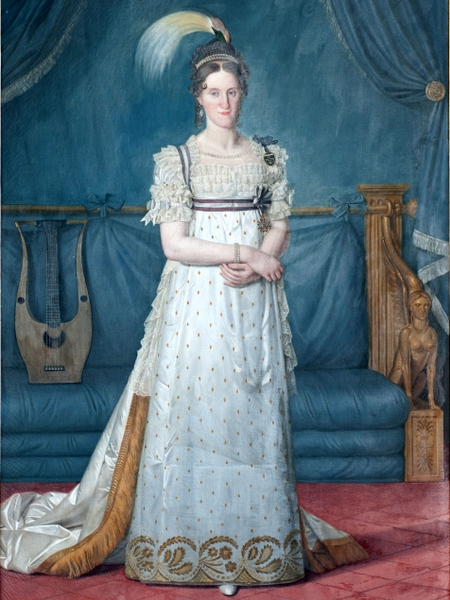
The city’s local authorities organised the first parade in their honour to mark the royal visit.
Prominent residents of Nice dressed in elegant costumes paraded on decorated carriages past the palace balcony.
![Nice Carnaval in 1916 [Public Domain]](https://frenchmoments.eu/wp-content/uploads/2016/01/Nice-Carnaval-in-1916-Public-Domain.jpg)
![Confetti Battle in Nice circa 1905 [Public Domain]](https://frenchmoments.eu/wp-content/uploads/2016/01/Confetti-Battle-in-Nice-circa-1905-Public-Domain.jpg)
![Confetti Battle in Nice circa 1904 [Public Domain]](https://frenchmoments.eu/wp-content/uploads/2016/01/Confetti-Battle-in-Nice-circa-1904-Public-Domain.jpg)
![Confetti Battle in Nice circa 1905 02 [Public Domain]](https://frenchmoments.eu/wp-content/uploads/2016/01/Confetti-Battle-in-Nice-circa-1905-02-Public-Domain.jpg)
The show must go on… without the presence of King!
The first parade was a success and was renewed in the following years in the king’s absence. The people of Nice made themselves of the king of straw and old clothes and placed him on the palace balcony.
In 1882, it was decided that the mock king should participate in the parade by signalling the beginning of the festivities.
![Nice Carnival in 1915 [Public Domain]](https://frenchmoments.eu/wp-content/uploads/2016/01/Nice-Carnival-in-1915-Public-Domain.jpg)
This explains why the arrival of the royal float with its gigantic character is such an important moment during the Nice Carnival. It is tradition for the king to preside over the carnival on the Place Masséna during the festivities.
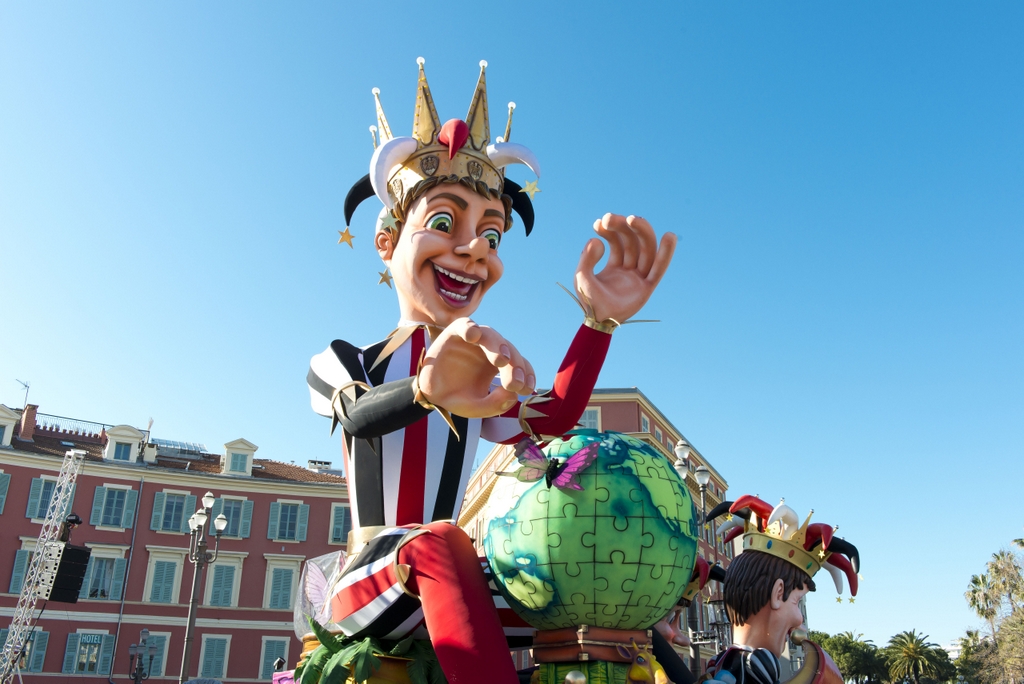
On the final night of the carnival, the king’s effigy is put out to sea on a little boat and burned before the traditional fireworks of the Bay of Angels.

During the 2nd half of the 19th century, the festival attracted the international elite and became a real show with floats and tribunes (introduced in 1873). The Flower Parade was introduced in 1876 as a simple exchange of flowers.
The editions of the Nice Carnival
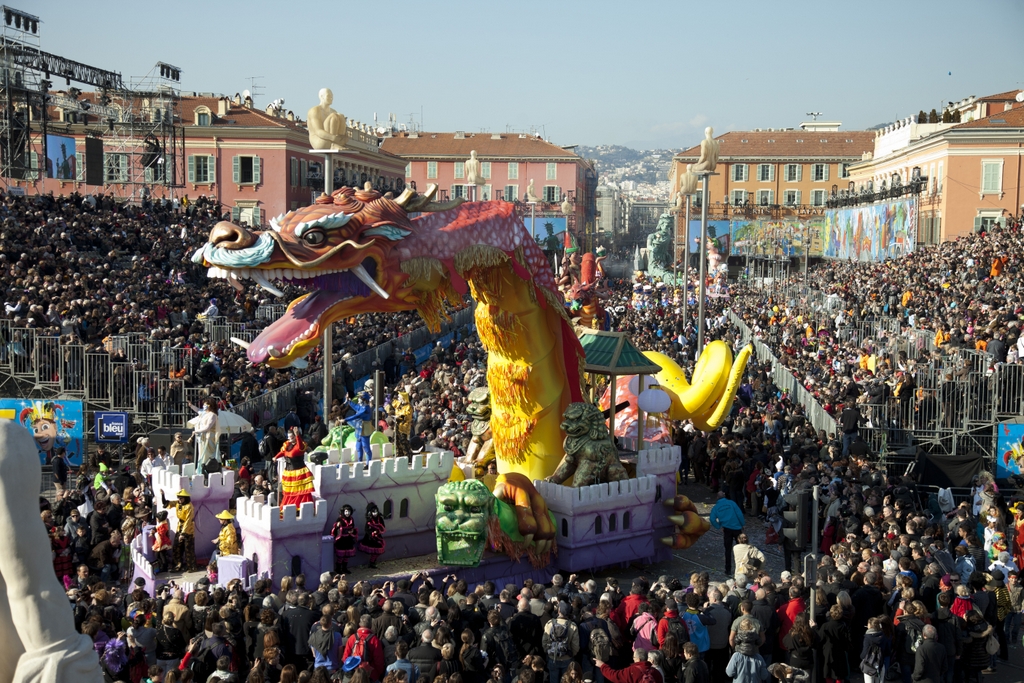
In 2024, the Nice Carnival will occur from the 17th of February to the 3rd of March.
Every year, the king presided over the parade based on a specific theme:
- 2010: King of the Blue Planet
- 2011: King of the Mediterranean Sea
- 2012: King of Sport
- 2013: King of the Five Continents
- 2014: King of Gastronomy
- 2015: King of Music
- 2016: King of the Media
- 2017: King of Energy
- 2018: King of Space
- 2019: King of Cinema
- 2020: King of Fashion
- 2022: King of the Animals
- 2023: King of the World’s Treasures
- 2024: King of Pop Culture
The Carnival’s Two Main Parades

The carnival is a modern, high-quality show with a creative procession of floats comprising two events: the Carnival Parade (Corso Carnavalesque) and the Flower Parade (Bataille de Fleurs).
The Carnival Parade (Corso Carnavalesque)
The Carnival Parade occurs on the Place Masséna and around the Jardin Albert 1er.
The event features two parades:
- a Day Parade (Corso Carnavalesque), and
- a Night Parade (Corso Carnavalesque Illuminé) on Saturday and Tuesday nights.
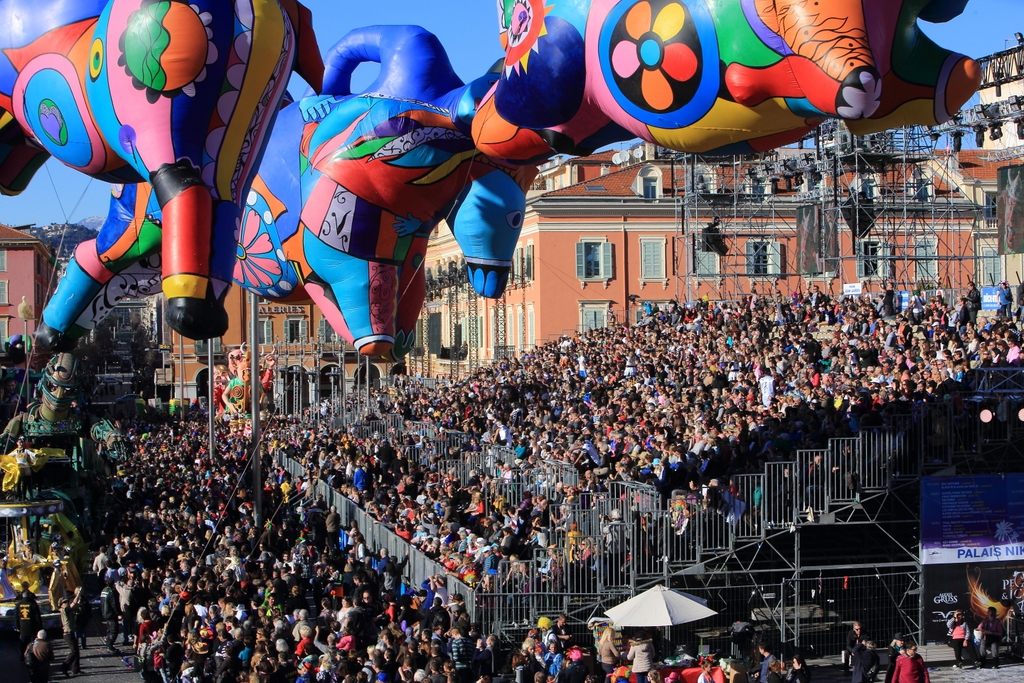
The parade works its way up to a crescendo of gigantic celebrations with three leading floats:
- the King’s,
- the Queen’s, and
- Carnivalon’s, their son… and for the first time in 2020, the child will be a girl!

Each of the floats is meticulously designed by the ‘Ymagiers’.
The ‘Carnivaliers’ are the artist-craftsman who create the float with the performance elements. Then, artistic coordinators oversee the passage to 3D.
The 17 floats measure 12 m long by 3 m wide and 8 to 17 m high.
The particularity of the parade is to feature “Grosses Têtes” (Big Heads), similar to the traditional carnivals in Flanders.
The Flower Parade (Bataille de Fleurs)
The Flower Parade also takes place on Place Masséna. In French, it takes the name “Bataille de Fleurs” (literally “Battle of Flowers”).
The flower-decked floats of the parade are ridden by extravagantly dressed performers who throw out mimosas, gerberas, and lilies to the public.
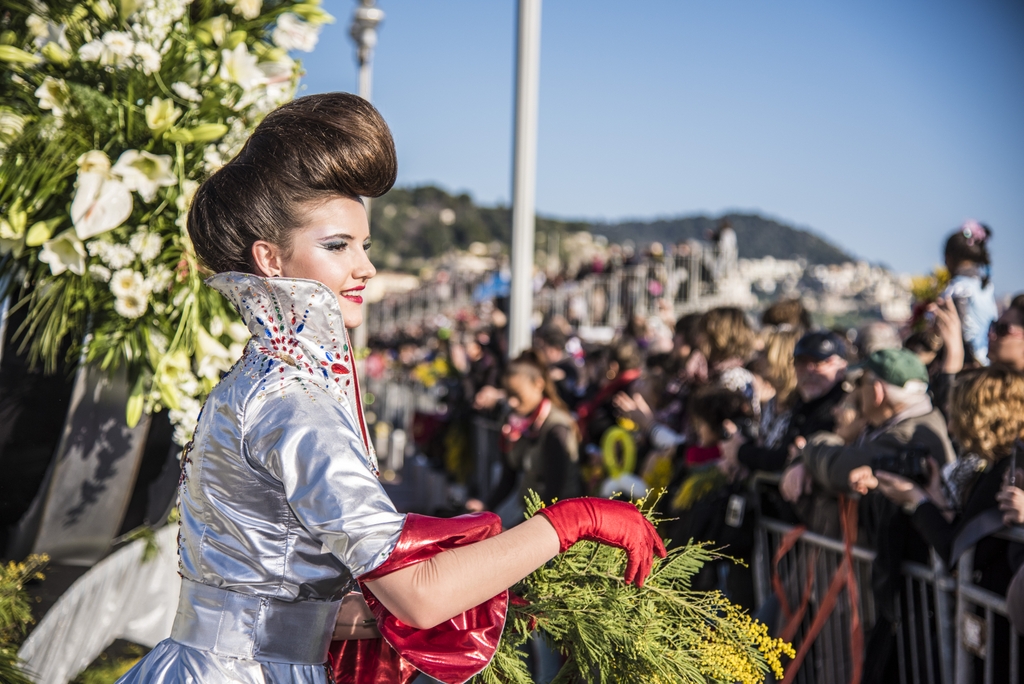
The 16 floats of the parade are 7m long by 2m wide and 6m high. Each float includes about 3,000 stems, 75% produced in the Nice region. Flower pricking takes 72 hours.
The Carnival Queen
Every year, Nice nominates its Carnival Queen to represent the spirit of the Flower Parade.
![Flower Parade in Nice © Zil - licence [CC BY-SA 3.0] from Wikimedia Commons](https://frenchmoments.eu/wp-content/uploads/2016/01/Flower-Parade-in-Nice-©-Zil-licence-CC-BY-SA-3.0-from-Wikimedia-Commons.jpg)
![Flower Parade in Nice © Zil - licence [CC BY-SA 3.0] from Wikimedia Commons](https://frenchmoments.eu/wp-content/uploads/2016/01/Flower-Parade-in-Nice-02-©-Zil-licence-CC-BY-SA-3.0-from-Wikimedia-Commons.jpg)
![Flower Parade in Nice © Zil - licence [CC BY-SA 3.0] from Wikimedia Commons](https://frenchmoments.eu/wp-content/uploads/2016/01/Flower-Parade-in-Nice-04-©-Zil-licence-CC-BY-SA-3.0-from-Wikimedia-Commons.jpg)
![Flower Parade in Nice © Zil - licence [CC BY-SA 3.0] from Wikimedia Commons](https://frenchmoments.eu/wp-content/uploads/2016/01/Flower-Parade-in-Nice-03-©-Zil-licence-CC-BY-SA-3.0-from-Wikimedia-Commons.jpg)
Did you know? The Flower parade inspired Isabel, Princess Imperial of Brazil, for the first flower procession in Rio de Janeiro.
Good to know about the Carnival of Nice!
Here is some practical info about attending the Carnival of Nice (For updates on the 2024 edition, please refer to the official website)
Booking your ticket
To attend the carnival’s parades, you can either:
- Reserve your seat in one of the 4 Tribunes (Verdun, F. Faure, Jean Jaurès and Phocéens)
- Book your ticket to the Promenoir (standing area). There are two areas: Zone A = Place Masséna, Zone B = Around Jardin Albert 1er.
- Adults and children in full fancy dress get free admission to the Corsi parades (in the standing areas)! For this, you’ll need to come disguised from head to toe. And avoid costumes that could lead to confusion with a religious, military or offensive character, of course!
- A package starting from 40 euros allows you to attend the Day or Night Parade + the Flower Parade in the reserved seating areas (except Saturdays).
- More info about the Carnival’s Rates.
- Book your ticket online here.
Dos and Don’ts!
There are four entrance points (E on the map)
To avoid lengthy queues, arrive at least one hour before the show starts.
And when possible, bring a minimum of personal belongings (as no lockers are available during the event).
Do remember that no re-entry is permitted.
You can’t access the site with your pet. I know you don’t want your dear animal to be scared (or to scare others!!)
Lastly, I know this makes common sense, but remember it’s forbidden to come with:
- blades, blunt and pointed objects
- weapons, even replica and fake
- weapons and ammunition of any category, tear bombs
- explosive, flammable or volatile substances (fireworks, firecrackers, Bengal fires)
- alcoholic beverages, illicit substances, glass and metal containers (cans, glass bottles), plastic containers with cap
- motorbike helmets
- tripods
- folding seats
- metal spray cans, including Carnival silly string sprays …
- suitcases, shopping bags and other bags and luggage
- rolling objects (rollerblades, scooters, skateboards, bicycles, etc.), excluding strollers and wheelchairs.
Always check on the festival’s site to see if the parades you’re meant to attend are still on. Bad weather could result in its cancellation. In 2020, the last two parades scheduled for Saturday, 29 February, were cancelled to preserve public health (despite the absence of a COVID-19 case detected in Nice).
If you’re attending the carnival, post your photos on social media with the hashtags #NiceCarnaval and #ILoveNice.
Apart from this, attend the carnival and HAVE FUN!
What do you do in Nice besides the Carnival?
Here are a few options for what to do in Nice besides the Carnival:
Find out more about Nice, France

- This is the link to the official website of the Nice Carnival [in English]
- The Tourist Board of Nice Côte d’Azur
- Click here for how to come to Nice (by car, train, plane, boat and coach)
Where to stay for the Carnival of Nice?
Find a selection of accommodation here, or this map will help you find where to stay in Nice according to location and prices:
Featured image: Nice Carnival, The King © H. Lagarde – OTC Nice




